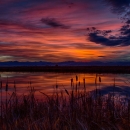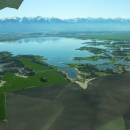About Us
The Benton Lake Wetland Management District contains 23 Waterfowl Production Areas totaling over 16,000 acres. These WPAs are scattered throughout 8 counties (Cascade, Choteau, Glacier, Hill, Pondera, Powell, Teton, Toole) and include many great hunting locations and bird watching sites. The District was established in 1975 and includes 3 conservation areas, and 4 distinct easement programs.
There are several types of Refuge System lands within the wetland management district wetland management district
A wetland management district is a U.S. Fish and Wildlife Service office that manages waterfowl production areas in one or more counties. Waterfowl production areas are small natural wetlands and grasslands that provide breeding, resting and nesting habitat for waterfowl, shorebirds, grassland birds and other wildlife. The Fish and Wildlife Service acquires waterfowl production areas under the authority of the Migratory Bird Hunting and Conservation Stamp Act, primarily using funds from the sale of Federal Duck Stamps. The Refuge System’s 38 wetland management districts comprise thousands of waterfowl production areas – almost all in the Prairie Pothole Region of the Northern Great Plains.
Learn more about wetland management district :
- Waterfowl production areas, which are acquired in fee-title
- Perpetual wetland easements, which protect privately owned wetlands from being drained, filled, or leveled, while the landowner keeps all other rights
- Perpetual grassland easements, which protect privately owned rangeland and hay land from conversion to cropland, and the landowner keeps all other rights
- Perpetual Farmers Home Administration conservation easements, which help farmers reduce their debt load on farmland and protect wetlands and grasslands
- Perpetual conservation easements, which primarily protect wetland and grassland habitats and prevent property from being subdivided for residential, commercial, or industrial purposes
- A grassland and wetland parcel leased from the State and managed similarly as a waterfowl production fee-title unit
Our Mission
Refuge conservation plans are called “comprehensive conservation plans”.
The purpose of a comprehensive conservation plan is to specify a management direction for the Refuge for the next 15 years. The goals, objectives, and strategies for improving Refuge conditions—including the types of habitat we will provide, partnership opportunities, and management actions needed to achieve desired conditions – are described in the recently updated comprehensive conservation plan. The Service’s management direction for the Refuge and its effects on the human environment, are described in the comprehensive conservation plan as well.
The comprehensive conservation plan identified the following vision for the Benton Lake National Wildlife Refuge Complex:
The spirit of the American West Resonates on both sides of the Continental Divide in the prairies, mountains, rivers, and wetlands of the Benton Lake National Wildlife Refuge Complex. Here, migratory birds fill the sky, bull trout thrive, and grizzlies and wolves still roam. Visitors experience many of the same landscapes that Lewis and Clark explored on their journey through the “Crown of the Continent.” Conservation efforts in the refuge complex protect intact landscapes, manage productive habitats, and offer people opportunities to connect with wildlife in solitude under Montana’s big sky. These efforts rely on innovative public and private partnerships, are supported by the region’s people, and harmonize with the historic rural economy.
Our History
Waterfowl production areas and wetland and grassland easements are bought from, or donated by, willing sellers through the Small Wetlands Acquisition Program authorized by the U.S. Congress in 1958 as an amendment to the Migratory Bird Hunting and Conservation Stamp Act of 1934. This program is funded by the sale of Federal Duck Stamps and loans against future duck stamp sales. The purpose of this important program is to make sure the long-term protection of breeding habitat, primarily within the PPPLCC’s Prairie Pothole Region of the United States, for waterfowl and other migratory bird species.
Since 1958 when the Small Wetlands Acquisition Program began, the Service has acquired a perpetual, real property interest in more than 2 million wetland acres for waterfowl production in the Great Plains States, which include Montana. The district currently manages 7,098 acres of perpetual wetland easements. Conversion of grassland to cropland has generated a need for the protection of upland habitat next to wetlands. The loss of upland nesting cover has reduced the value and productivity of wetlands for nesting waterfowl and their broods, other migratory birds, and other wildlife. Grassland easements, like wetland easements, are perpetual and protect both existing and restored habitat.
Other Facilities in this Complex
Western Montana National Wildlife Refuge Complex
For the Western Montana National Wildlife Refuge Complex, the project leader is stationed at Benton Lake National Wildlife Refuge and oversees general management of the Complex. Refuge managers oversee the operations at specific refuges. Supporting staff, composed of administrative, law enforcement, refuge manager, biological, fire, visitor services, and maintenance professionals support all refuges within the complex.
The Complex headquarters is located at Benton Lake National Wildlife Refuge, 922 Bootlegger Trail, Great Falls MT 59404.
The refuges in the Western Montana National Wildlife Refuge Complex include:

